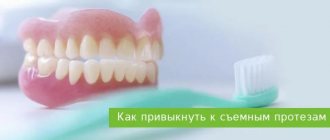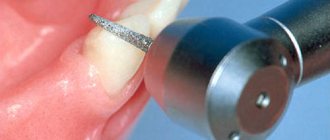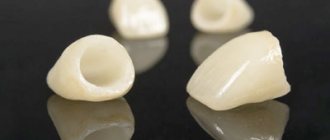Many patients of orthopedic dentists after prosthetics talk about how difficult it was for them to get used to dentures. High-quality permanent artificial teeth and crowns are compact in size and do not cause any discomfort. But with removable ones, problems arise: from unpleasant sensations in the palate and irritating pressure on the gums to constant nausea and even a gag reflex. Each patient experiences the adaptation process in his own way, so it can last only a couple of days, one or two weeks, or several months.
Why does discomfort occur?
A person with missing teeth gets used to living without them. His dental system begins to distribute the chewing load differently, and the muscles, cheeks, nerves, tongue and jaw bones involved in the process gradually get used to the restructuring that has occurred.
If missing teeth can be restored with permanent dentures, the parameters of which are almost identical to natural teeth, the load when chewing food turns out to be natural. And the absence of foreign elements - fixing hooks and staples - guarantees the absence of irritation of the mucous membranes of the cheeks and tongue.
In removable structures, the chewing load is distributed differently. For example, popular clasp dentures distribute it to the palate and the remaining adjacent teeth. It is clear that the sensations when chewing food will be unusual at first and will almost certainly cause irritation.
Why does a tooth hurt under a crown: reasons
Thus, if you have a toothache under the crown or the gums under the crown are inflamed, the reason almost always lies in poor-quality therapeutic preparation of the tooth for prosthetics. Of course, in most cases, dental therapists take control photographs after filling the canals, but even if they see mistakes, most doctors simply will not waste time and redo something.
Unfortunately, this approach in Russia is the norm rather than the exception. And if your tooth hurts under the crown, then the first thing you should do is an x-ray, which will show one of the main mistakes that dentists make when filling root canals. The image will show whether the tooth can be treated or whether it needs to be removed. The most common mistakes made by doctors include...
Root canals are not filled to the root apex –
Let us remind you that in most cases, teeth must be depulped before prosthetics. Depulping a tooth means that the dental pulp (neurovascular bundle) is removed from it and the root canals are filled. When filling root canals, there are certain standards, the implementation of which helps prevent subsequent inflammation in the area of the tooth roots.
In Fig. 1,2 you can see how well-filled root canals look on radiographs. However, when the doctor does not work and fills the canals not to the top of the root, conditions are created in the unsealed part of the canal for the spread of infection. Failure to fill the canal by just 1-2 mm can already cause inflammation at the apex of the tooth root (Fig. 3).
On X-ray 3 you can clearly see the unfilled part of the root canal (it is shown by a white arrow). Black arrows show the boundaries of a periodontal abscess, which on an x-ray looks like intense darkening in the area of the root apex. The reason for its formation is the development of infection in the unfilled part of the root canal. This dental disease is called periodontitis.
What does inflammation of a tooth look like under the crown (Fig. 4) –
- "Gutta-percha" is a material for canal filling,
- “periapical abscess” is a focus of purulent inflammation in the form of a purulent sac at the apex of the root (depending on the size of the purulent focus, the latter is called either a granuloma or a radicular cyst).
Poor obturation of root canals –
Inflammation can also be caused by poor obturation of the root canal with filling substances (gutta-percha and sealer). Those. the canal can even be sealed to the top of the root, but it is not sealed tightly, with many pores and empty spaces.
This could also be the reason why your tooth hurts under the crown, because... Such poor-quality canal filling also leads to the development of inflammation at the apex of the tooth roots. Poor canal obturation can also be easily determined by a targeted photograph of the tooth.
Perforation of the walls of the root canal –
Perforation is literally “a non-physiological hole.” In other words, this is a hole in the root of the tooth that is created artificially. The only physiological hole in the tooth is at the top of each root. The most common perforations that occur are:
- During instrumental treatment of root canals - using tools for mechanical expansion of the root canal, the doctor can make a number of mistakes. For example, instead of expanding the root canal along its course (from the mouth of the canal to the apex of the root), the doctor will direct the instrument perpendicularly through the canal wall, which will lead to the appearance of a “hole” in the root wall (Fig. 5, 6).
- During fixation of the pin in the root canal, doctors also very often allow perforations if the technique for fixing the pins in the root canal is not followed. Such perforations are also determined by radiographs and corresponding symptoms (Fig. 7).
Fracture of an instrument in the lumen of the root canal –
This happens quite often, but in most cases it is again due to the fault of the doctor. Below you will read about the main reasons for instrument failure in the canal. The only good reason for a breakdown that cannot be blamed on the dentist is if your root canals have a very severe curvature.
- Violation of the technique of rotating the instrument in the root canal - instruments for treating root canals are quite thin and require strict adherence to a certain technique of use. For example, most instruments cannot be rotated more than 120 degrees in the root canal. If the instrument is rotated 360 degrees in the root canal, this can naturally cause a fracture of the instrument, which is associated with the curvature of the root canals.
- Reuse of instruments—breakage of instruments can also occur due to the fact that the doctor uses “old instruments.”
Instruments for mechanical expansion of root canals are made of special metal. Any metal gets microcracks during loading, which is called “metal fatigue.” Repeated use of an instrument for root canal treatment greatly increases the risk of instrument breakage (24stoma.ru). Tools for canal treatment come in different sizes and differ in thickness. The thinnest instruments have sizes No. 6,8,10, 15. In Europe and the USA, such instruments are generally disposable and their reuse is not allowed. Instruments of other sizes can be reused after sterilization. But in Russia, in the vast majority of clinics, in order to save money, no one throws away such instruments, and they work with them “to the limit.” What affects the incidence of tool breakage. - When working in highly curved, difficult-to-pass channels - In this case, instrument failure may occur through no fault of the doctor, because
Instrumentation in such root canals is itself risky. But you cannot refuse and not do it. The presence of a foreign body (piece of instrument) in the root canal or beyond can be determined using an x-ray (Fig. 8, 9). And the problem here is that in most cases it is not possible to remove the instrument fragment from the canal. This prevents high-quality filling of the root canal, which in the vast majority of cases leads to inflammation developing, the tooth under the crown aching, or the gums under the crown hurting.
What inconveniences can you encounter after prosthetics?
Dentists installing dentures in Moscow warn in advance about possible discomfort that may manifest itself:
- noticeably irritating sensation of a foreign body in the oral cavity;
- pain caused by the pressure of the structure on the supporting teeth and especially the gums;
- rubbing of mucous membranes, redness and swelling, formation of bedsores on the gums;
- a feeling of poor closure of the jaws and teeth;
- increased salivation caused by the perception of the prosthesis as food that needs to be easier to move from the mouth to the throat;
- the appearance of gagging as a reaction to the presence of a foreign body in the mouth;
- impaired diction, which can be caused by even the best removable dentures (the tongue needs time to get used to changing position when pronouncing sounds);
- partial loss of taste of products caused by the closure of certain areas of the oral mucosa by the prosthesis.
Causes of pain after turning
Discomfort in the oral cavity after partial removal of enamel and dentin is common. If the pulp has not been removed, the prepared tooth may be painful for 3-7 days. Unpleasant sensations worsen when drinking cold and hot drinks, hard foods, sour foods and sweets. This is a normal option, since increased sensitivity is due to thinning of hard tissue.
The cause of pain may be a violation of the teeth preparation technique. If the doctor worked without stopping, tissue overheating could occur. In this case, unpleasant sensations occur throughout the day, and not just in response to external stimuli. Pain can also be associated with removing too thick a layer of dentin and exposing the nerve of the tooth. The only solution to the problem is to remove the pulp.
After grinding, not only the tooth, but also the gums may hurt if a retraction thread was used during the procedure. It pushes back the edge of the gum and often injures it.
Do you really have to put up with this?
Making dentures is quite a complex job, in some ways even comparable to art. Working in tandem, the orthopedic surgeon and the dental technician put a lot of effort into making an accurate and as comfortable prosthesis as possible. But in most cases, after putting it on and wearing it, it turns out that it needs some adjustment to the patient’s gums.
To regain lost comfort, you need to walk with the installed structure for 3–4 weeks. During this time, you can get used to the initially interfering prosthesis and get rid of the unpleasant sensations. If you simply remove it when discomfort appears, then you will have to describe all the inconveniences experienced in words, and the doctor will not be able to understand what exactly caused them. Do you want the correction to be effective? Be sure to come to your appointment wearing a prosthesis that causes discomfort.
Correction of dentures is carried out within 15–20 minutes. As a rule, it is possible to restore the patient’s comfort in one or two visits to the dental clinic.
When does pain occur under the crown?
Only an orthopedic dentist can answer the question why a tooth hurts under a crown.
Sometimes it's all about the nerve endings. When everything is artificially recreated, the nerve fibers begin to sound the alarm. There is nothing wrong with this, in addition, tooth pain under the crown can appear either after a short time or years.
However, pain in the crown of the tooth can also be caused by other reasons:
If the nerve is preserved, then it is the nerve under the crown of the tooth that may hurt. Here we are talking about insufficiently good treatment of caries. Poorly treated caries subsequently causes pulpitis.
If the tooth under the crown hurts when pressed, this may indicate pulpitis, excess filling material, or injury to the root walls when using a drill.
The nerve may be touched or injured, or burned while the hard dentin tissue is being ground down.
Many orthopedic doctors (and therapists too) advise immediately removing the nerve before installing a crown prosthesis, and not wait until this “time bomb” triggers pain for the patient after installing the crown in 1-2 years.
If the crown of a tooth hurts when pressed immediately after dental procedures, you should not panic, as this is a normal reaction of the body to intervention.
When a living tooth hurts under the crown and does not go away, or acute pain appears under the crown of the tooth, this indicates an urgent visit to the dentist.
In a situation where a pulpless tooth under the crown hurts, i.e. the nerve is removed, but it still ache, then the pin may be installed incorrectly. In such cases, the pin is removed and the tooth is restored using the CEREC pinless rapid restoration technology, when a single tooth module “root + crown” is manufactured, see video:
Working with an expander sometimes damages the bone tissue of a tooth unit. Even if everything is tightly filled with filling material, the person will feel pain.
In all these situations, painful sensations can also arise from changes in temperature, cold or hot, and the pain can also intensify at night.
Causes of painful sensations in teeth
1. Physiological response to intervention
This is the most common reason why teeth and gums hurt after grinding for crowns and other orthopedic structures. After all, during the procedure, the specialist acts on the tissue instrumentally and medicinally, touching the nerve endings. This reaction is considered normal.
On a note! If, after grinding teeth, hyperesthesia (increased sensitivity) and aching pain appear, especially during the consumption of cold, hot, sour and spicy foods, and hygienic cleaning, then this often simply indicates a thinning of the tissue area of the prepared unit.
Most often, hyperesthesia after turning occurs on vital, that is, living units where the pulp is preserved. Sensitivity is enhanced even despite the presence of temporary crowns, which, it would seem, serve as reliable protection from external irritants. Temporary structures are fixed immediately after preparation and worn until permanent dentures are created.
Medical errors
If a tooth or gum hurts after grinding, then unqualified actions by the doctor cannot be ruled out. Most often, inexperienced specialists make the following mistakes:
- overheating of the pulp: occurs when preparing tissue with a bur,
- removing too much tissue,
- nerve injury: to avoid complications associated with damage, overheating or inflammation of the nerve under the prosthesis, experienced specialists advise depulping the tooth, that is, first removing the pulp from it.
If the doctor made the mistakes listed above, then the pain makes itself felt almost immediately after the procedure and can persist for several weeks or even months.
3. Development of a pathological inflammatory process
If a lot of time has passed after medical manipulations, and you have severe discomfort and your teeth hurt after grinding for crowns and bridges, then this signals the development of various dental diseases: caries, pulpitis, periodontitis, cyst, granuloma, fistula, abscess, gumboil. In this case, the pain does not go away for a long time, intensifies with each subsequent day, and is poorly relieved by analgesics. Along the way, other alarming symptoms arise: purulent bumps appear on the gums, the gums and cheek swell, the body temperature rises, it becomes painful to chew and press on the causative element.
More often, the problem arises again due to the fault of a clinic specialist who, during the preparation and preparation of tissues before prosthetics, violated the rules of asepsis, did not fully treat (after all, dentures are often placed on teeth destroyed by deep caries and other dental diseases), poorly cleaned and poorly sealed the roots channels. Pulpitis can occur if, in the process of preparing the “support,” the doctor caused irreversible damage to the nerve.
Expert opinion
Andrey Rastislavovich Chernov
Specializations: Orthopedic dentist
Experience: 11+
“Treatment, grinding and prosthetics of a tooth with an orthopedic design is a complex and multi-stage process, in which at least several experienced specialists must take part - a therapist, a dental technician (creates a prosthesis using casts of the jaws), an orthopedic doctor. If everyone has done their job efficiently, then pain after completing all the manipulations should not arise either in the short or long term.”
Sometimes a pathological inflammatory process occurs due to the fault of a patient who systematically violates oral hygiene, does not monitor the condition of installed dentures and surrounding tissues, and receives various injuries.
Methods of tissue trimming: after which procedures pain occurs more often
There are different ways to prepare tissue. According to experts, after grinding the teeth, some of them may actually experience aching pain. But other methods, on the contrary, are considered gentle, and therefore do not cause discomfort at any stage of treatment and prosthetics.
Using a diamond-tipped bur
The drill, despite the loud, annoying sound, is still popular among dentists, because with its help you can quickly and efficiently carry out work of any level of complexity and scale, and grind off any amount of tissue.
It is boron that is most often used for preparing tissue for crowns and bridges, and for turning teeth for veneers. During the process, the doctor uses the device at different speeds so that it does not cause overheating of the tissues and pulp; at the same time, a cooling liquid is supplied to the oral cavity. Despite all the safety measures, many patients note that it was after using boron that they experienced pain.
Via ultrasound
Situations where a tooth hurts after grinding performed using ultrasound are quite rare. The method is characterized by a more gentle effect, compared to boron[1], allows you to process fabrics carefully and without contact, and does not cause overheating. However, ultrasound can still cause discomfort and short-term increased sensitivity of hard tissues and gums in people with a low pain threshold and weakened enamel.
The method is used if you need to remove a small amount of tissue.
Laser method
Here, a laser is used for preparation, which, like ultrasound, acts in a targeted and non-contact manner. The method is considered one of the safest and most painless[2], suitable for people with sensitive gums and mucous membranes, and does not cause pain or discomfort. The laser not only carefully grinds the tissues, but also disinfects them, promotes rapid healing, and prevents bleeding.
Water-abrasive treatment
Suitable only in cases where a minimum amount of tissue needs to be removed. During the process, a specialist treats the enamel with a stream of water containing abrasive particles. After such grinding of teeth, aching pain and any discomfort are completely excluded.
On a note! Until recently, dentistry also used a chemical method, where tissues were first softened using chemicals and then removed with an instrument. However, today this method is recognized as traumatic and very dangerous for the nerve of the tooth.









